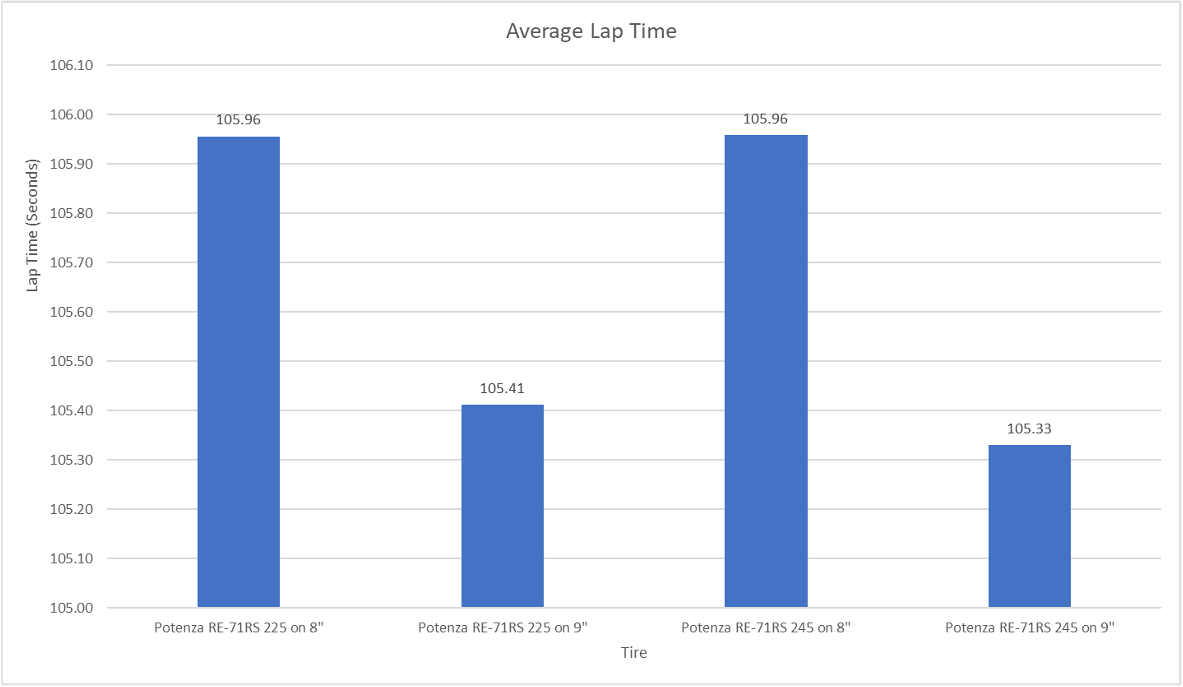June 22, 2023
Vehicles Used
2022 Subaru BRZ Limited
In 2022, we compared 9 different tire and wheel combinations on our test track in the search for the fastest combination. You can find that full report here, but ultimately, we found that using a wheel width that better supports the tire is more important to setting fast laps than tire width alone. That point was driven home by the fact that our 215/45R17 tire on a 9" wheel was dramatically faster than the 245/40R17 tire on the 7" wheel.
From the moment we finished that test (even while we were testing, in fact) we couldn’t help but wonder if those results would hold true on a road course with higher speeds and longer turns. Well, we don’t like to wonder, so we decided to find out. To that end, we took the four fastest specs from the previous test and headed up to the track, determined to get some answers.
As the test platform, we used our 2022 Subaru BRZ Limited test vehicles. To help them utilize more of the tires’ contact patch and ensure we didn’t wear through the outboard shoulders of the front tires, we added Whiteline adjustable camber bolts to give both cars identical alignments with 2.0 degrees of static negative camber at the front wheels. To make sure our brakes were up to the task, we installed front and rear TR Select Brake Kits with Hawk DTC-60 pads and Centric 120 Series rotors that delivered fade-free stopping performance throughout the test. The vehicles were fitted with new, full tread tires, and hot pressures were set at 32 psi.
Testing on the Track
225/45R17 tires on 17x8 wheels:
We said it last year when we tested on our track, and we’re saying it again after testing on the road course - the combination of 225/45R17 tires on 8" wheels just felt right. It’s as if this setup is the default, perfectly balanced with all traits in proportion, and any deviation alters the baseline in some way - or multiple ways. The steering felt alert and natural, with an intuitive response to inputs and effort that built perfectly as the load increased. Neither the front nor rear axle dominated the performance. All 4 tires were integrated in harmony, with a neutral balance that allowed for the perfect amount of rotation to carve a graceful little arc at corner exit. Average Lap: 1:45.96
225/45R17 tires on 17x9 wheels:
The 225/45R17 on 9" wheels felt like the 225 on the 8" in fast forward. This combination traded some of the "natural" feel for more immediacy. The nose was noticeably faster to turn in, and it changed directions effortlessly. The additional front-end authority didn’t upset the amazing balance, and it always felt stable, even when the driver was intentionally rotating the vehicle. With this combination, it was intuitive and helpful to rotate a touch at corner entry to set up the vehicle for the perfect approach trajectory toward the apex. When powering away from the turn, the rear axle allowed earlier commitment to throttle without any nervousness. Over the course of a lap, all these enhancements resulted in a half-second improvement, just by switching to wider wheels. Average Lap: 1:45.41
245/40R17 tires on 17x8 wheels:
In terms of lap times, the 245/40R17 tires on 8" wheels were identical to the 225/45R17 tires on 8" wheels, down to the hundredth of a second. Subjectively, however, the two combinations felt very different. The 245 on the 8" lost the direct connection between the drivers’ inputs and the contact patch, introducing a slight delay before orders were carried out. Turn-in was slower and the steering was a bit numb when loaded, and this combination wasn’t as happy doing two things at once. The results indicate the capability was there, but our drivers were unanimous that this was their least favorite spec in the test. Average Lap: 1:45.96
245/40R17 tires on 17x9 wheels:
With the combination of a 245 tire on a 9" wheel, the subjective feel was good, but not as magical as the 225 on the 9". The turn-in was strong but not immediate, and it was precise, but not scalpel-sharp like the stretched combo. There was some softness to its response to inputs of all kinds. The wider tire and wheel combination required a level of trust that it would do what was asked, whereas the 225 on the 9" just did it right now. Even so, the traction was at least as good as the narrower option, and some of our drivers preferred the 245/9" in the highest-commitment corners. Average Lap: 1:45.33
Summary
So, what did we learn? Just like last time, we’ve demonstrated that the combination of tire width and wheel width is more important than tire size alone. If you want to go faster, simply stuffing wider tires on your existing wheels isn’t likely to yield the results you want. In our last test and this test, the difference between the 225 on the 9" wheel and the 245 on the 9" wheel was small enough that it could reasonably be called a tie. The more-immediate response of the stretched combination likely tipped the scales on our tighter track, and the two were virtually identical on the bigger course. Once again, we’re betting a 245 on a 10" wheel would be the magic combination, if only we could fit it on our test cars. Regardless, though - the key takeaway to both tests is that properly supporting your tires is crucial to speed on the track.



